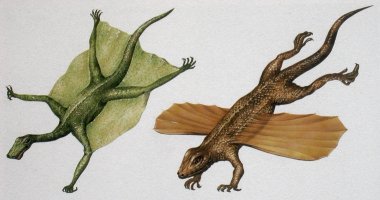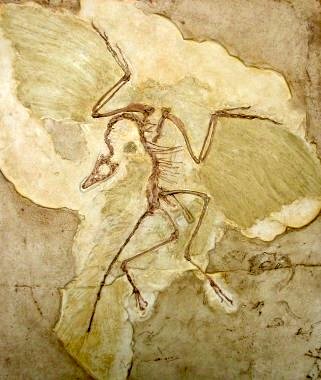Many animal species have developed wings and this happened in many different
ways. Insect wings are uncomparable with bird's wings. Where do these wings
come from? Something evolves when the animal has some advantage of it and
wings of a couple of centimeters do not give such an advantage. The answer
is that in most cases a change of function has appeared. Reptiles
often need an increase of their surface for the regulation of the temperature:
catching sunrays when it is cold and loosing warmth when it is very hot.
Some reptiles will have developed skin between the legs and the body for
that purpose. If these animals have moved through trees, they could have
had advantage of these skin flaps when they were hunted by a predator and
they could only save themselves by jumping down. The skin flaps broke the
fall and so they could escape. From that moment on natural selection
could start because the animals with the largest skin flaps were in favour.
In this way it is imaginable that a glider with skin flaps between the legs
like in the picture has come into existence.
The animal on the right is the Icarosaurus (!), which had stiff wings
strengthened with his lengthened ribs.
Know more?
Icarosaurus
(click also on the photo!)
|
Feathers, too, have probably developed to improve the temperature regulation.
But sexual selection could also be the reason. In recent years in China many
new finds have been done of hairy dinosaurs and even of whimpered hairs which
can be an early stage of feathers. Feathers are very suitable to keep heat
inside and cold outside. Also little dinos with wings and feathers have been
found. Or are these birds already? It is commonly assumed that birds descended
from dinosaurs. Or, otherwise said, that birds in fact are dinosaurs with
wings and feathers.
A change of function will have occurred: from temperature regulation or feathers
for sexual selection to the possibility to fly or to glide.
In the picture on top is one of the most famous fossils: the Archaeopteryx
or Urvogel from Solnhofen in Duitsland. It is still the oldest known
bird. It has feathers, wings and a tail. But next to bird's traits it has
also characteristics of a reptile like claws at the wings and teeth in the
beak. It is a beautiful example of a transitional form in the evolution,
also called a 'missing link'. This one, however, is not missing!
Know more?
Archaeopteryx
Transitional forms |

